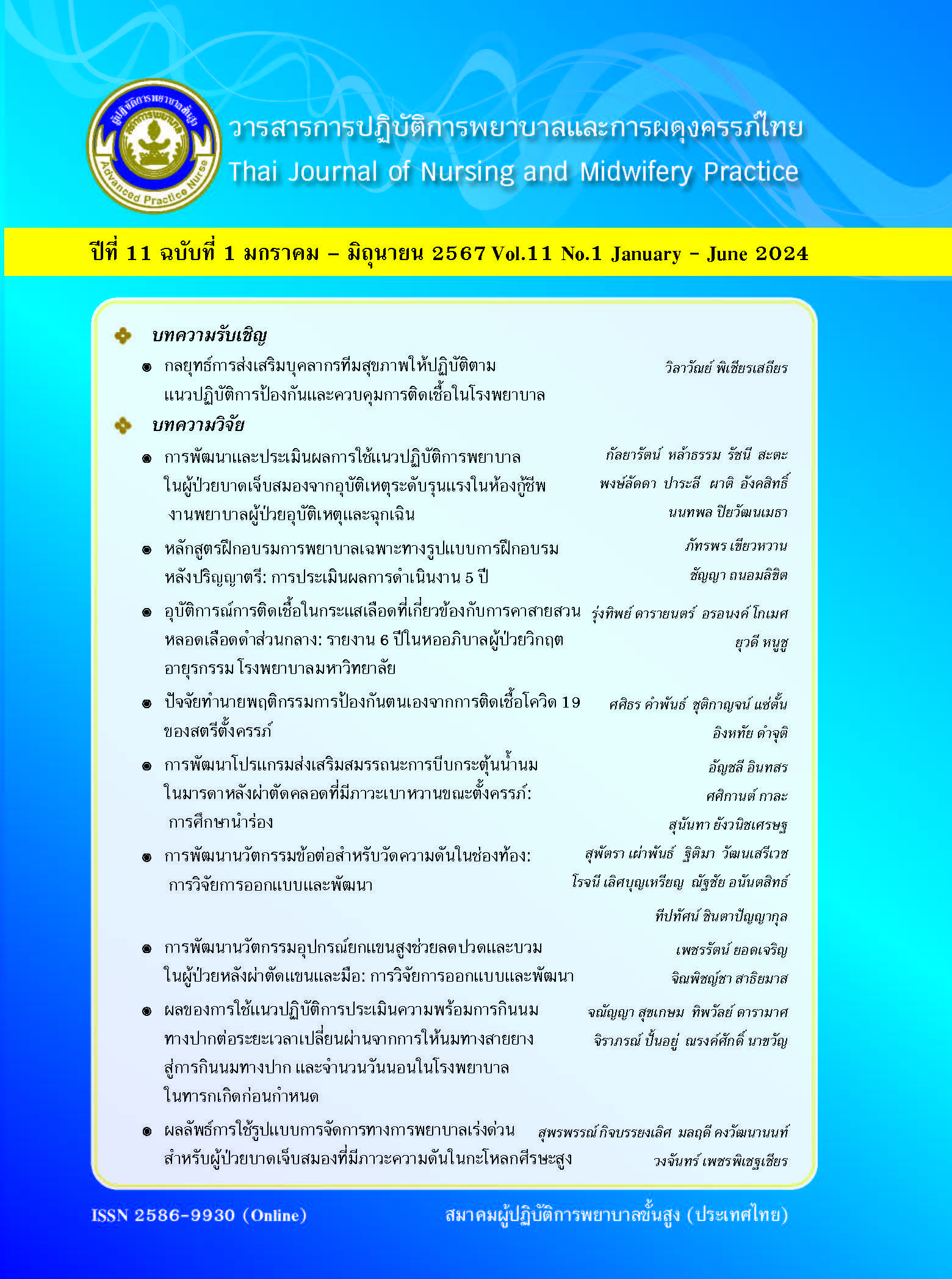Development and Evaluation of Nursing Practice Guideline in Patients with Severe Traumatic Brain Injury in the Resuscitation Room at an Accident and Emergency Department
Main Article Content
Abstract
Abstract: This research and development aimed to 1) develop nursing practice guidelines to prevent hypoxia and increase in intracranial pressure condition, 2) evaluate the feasibility and satisfaction of using nursing guidelines, and 3) evaluate patient outcomes. This study used Soukup’s evidence framework as a guide. The sample group consisted of 37 nurses and 63 patients with severe traumatic brain injuries. The research tools were the nursing practice guidelines, patient outcome record form, and a questionnaire on feasibility and satisfaction of use form. Data were analyzed using descriptive statistics and paired t-test. Results showed that the nursing guideline to prevent hypoxia and increase in intracranial pressure was developed from 14 items of evidence-based medicine, comprising 4 categories: (1) ventilator care, (2) patient positioning, (3) airway management, and (4) monitoring and used in patient care. After implementing, the guideline was highly feasible to use (M = 2.9, SD = 0.3) and nurses reported the highest level of satisfaction (M = 4.7, SD = 0.5). Patient outcomes were shown that average fingertip oxygen saturation and the carbon dioxide concentration in the end-exhaled breath before discharge were significantly increased than those at admission (p < .05), while the level of consciousness and blood pressure values at admission and before discharge were not different. So, clinical nursing practices should be used in patients with severe traumatic brain injury in the resuscitation room for preventing hypoxia and reducing the increase in intracranial pressure.
Downloads
Article Details

This work is licensed under a Creative Commons Attribution-NonCommercial-NoDerivatives 4.0 International License.
References
Sripontan J. Development of a care map for head injured patients by evidence-based practice in emergency department at Mahasarakham Hospital. Mahasarakham Hosp J. 2010; 7(2): 10-7. Thai.
Tantivisut S, Namvongprom A, Sirikul S. Effectiveness of nursing system development in using evidence-based protocol on quality of care in patients with severe traumatic brain injury. Journal of Nursing and Therapeutic Care. 2011; 29(3): 5-14. Thai.
Accident and Emergency Unit, Nursing Service Division, Srinagarind Hospital. Accident and Emergency Outpatient Unit Statistics A.D. 2018-2020. Khon Kaen: Srinagarind Hospital; 2020. Thai.
Cowley NJ, da Silva EJ. Prevention of secondary brain injury following head trauma. Trauma. 2008; 10(1): 35-42. doi: 10.1177/1460408608
McNett M, Doheny M, Sedlak CA, et al. Judgments of critical care nurses about risk for secondary brain injury. Am J Crit Care. 2010; 19(3): 250-60. doi: 10.4037/ajcc2009293.
Potaya S. Prevention and risk reduction of secondary brain injury. EAU Heritage J Sci Technol. 2019; 13(3): 22-31. Thai.
Haddad SH, Arabi YM. Critical care management of severe traumatic brain injury in adults. Scand J Trauma Resusc Emerg Med. 2012; 20(12): 1-15. doi: 10.1186/1757-7241-20-12.
Carney N, Totten AM, O’Reilly C, et al. Guidelines for the management of severe traumatic brain injury, fourth edition. Neurosurgery. 2017; 80(1): 6-15. doi: 10.1227/NEU.0000000000001432.
Kitkhuandee A, Tiamkao S, Sumanont S, et al. Clinical practice guideline of traumatic brain injury for medical personnel (CPG TBI) second edition 2013: Successful head injury fast track (SHIFT). Khon Kaen: National Health Security Office Khon Kean Branch (Region 7); 2013. Thai.
Teeratakulpisarn P. Initial assessment and management in trauma patient. In: Thanapaisal C, Wongkonkitsin N, Techaatik P, Sumritrin S, editors. Trauma life support in emergency room. Khon Kaen: Faculty of Medicine, Khon Kaen University; 2019. p. 17-36. Thai.
Norasan S. Head injuries. In: Saimai P, Norasan S, editors. Trauma nursing. Bangkok: Faculty of Medicine Ramathibodi Hospital, Mahidol University; 2016. p. 101–32. Thai.
Techaatik P, Wunsupong S, Sumritrin S. Effectiveness of implementing evidence-based practice for traumatic patients at the Out Patient of Accident and Emergency Unit. Khon Kaen: Accident and Emergency Unit, Nursing Service Division, Srinagarind Hospital; 2012. Thai.
Damkliang J, Considine J, Kent B, et al. Initial emergency nursing management of patients with severe traumatic brain injury: Development of an evidence-based care bundle for the Thai emergency department context. Australas Emerg Nurs J. 2014; 17(4): 152-60. doi: 10.1016/j.aenj.2014.05.005.
Damkliang J, Considine J, Kent B, et al. Using an evidence-based care bundle to improve Thai emergency nurses’ knowledge of care for patients with severe traumatic brain injury. Nurse Educ Pract. 2015; 15(4): 284-92. doi: 10.1016/j.nepr.2015.03.007.
Soukup SM. The Center for Advanced Nursing Practice evidence-based practice model: promoting the scholarship of practice. Nurs Clin North Am. 2000; 35(2): 301-9.
Diloksakulchai F. Evidence-based nursing principle and method. 4th ed. Bangkok: Faculty of Nursing, Mahidol University; 2008. Thai.
Chow SC, Shao J, Wang H, editors. Sample size calculations in clinical research. New York: Marcel Dekker; 2003.
Thamcharoentraku B, Saensom D. Supra-cuff Suctioning: innovation for ventilator-associated pneumonia prevention Supra-cuff Suctioning: Innovation for ventilator-associated pneumonia prevention. JBCNM. 2018; 24(1): 130-42. Thai.
Best JW. Research in education. 3rd ed. Englewood Cliffs (NJ): Prentice-Hall; 1977.
Phunawakul S, Reungsri S, Montarak O, et al. The development of clinical nursing practice guideline for patients with surgery from traumatic brain injury in Phichit hospital. J DMS. 2017; 42(6): 102-7. Thai.
Pumipichet A. Mechanical ventilation management in the emergency room. In: Permpikul C, Chakorn T, editors. First hour in emergency room: The practical approach. 2012. Bangkok: Department of Emergency Medicine, Faculty of Medicine Siriraj Hospital,
Mahidol University; 2012. p. 112-31. Thai.
Hanmanop P, Sriraksa A. Effects of suctioning apply program on oxygen saturation and vital signs post brain surgery in head injury patients with mechanical ventilator. Journal of Nurses’ Association of Thailand, North-Eastern Division. 2012; 30(2): 106-13. Thai.
Pedersen CM, Rosendahl-Nielsen M, Hjermind J, et al. Endotracheal suctioning of the adult intubated patient-what is the evidence? Intensive Crit Care Nurse. 2009; 25(1): 21-30.
Dumrongjitti P, Srisanit R, Duangdee P. Development of nursing practice guidelines for major trauma patients in Chaophya Abhaibhubejhr hospital. J Public Health Nurse. 2014; 28(1): 43-54. Thai.


